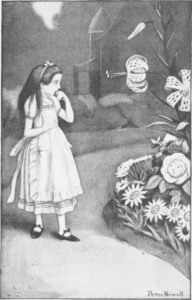 Flowers aren’t just pretty things we have in our yards: They’re also frequently featured in the stories we read. Sometimes, the characters are named after flowers, but other times, flowers play a prominent role in the story or are important symbols. Next time you’re on your back porch admiring the view, take a moment to think about how flowers have been used in some of our favorite stories.
Flowers aren’t just pretty things we have in our yards: They’re also frequently featured in the stories we read. Sometimes, the characters are named after flowers, but other times, flowers play a prominent role in the story or are important symbols. Next time you’re on your back porch admiring the view, take a moment to think about how flowers have been used in some of our favorite stories.
Tiger Lilies in Through the Looking Glass
Through the Looking Glass by Lewis Carroll is the 1872 sequel to the beloved Alice’s Adventures in Wonderland. In the book, the inquisitive heroine enters the topsy-turvy realm of strange mythological creatures, live chessmen, and rude insects. Among the whimsical characters she meets are talking flowers. In Chapter 2, “The Garden of Live Flowers,” Alice vents her frustration to a tiger lily, who surprises her by talking back. In the book, the live flowers help her discover that not everyone shares her assumptions.
Azaleas in Rebecca
Rebecca is a thriller novel that was published in 1938 by English author Daphne du Maurier. In the book, the heroine, Mrs. DeWinter, uncovers a beautiful valley with a stream that runs through a bed of azaleas, deemed the Happy Valley. The white azaleas were cultivated by Rebecca, the previous wife of our heroine’s husband Mr. DeWinter, and her things hold the scent long after she has passed away. In the story, azaleas represent Rebecca’s lingering presence at the DeWinter home and the family’s inability to move on from her passing.
Roses in A Rose for Emily
Published in 1930, A Rose for Emily is a short story written by American author William Faulkner. After experiencing a life of great tragedy, Emily, the main character, dies. The rose noted in the title of the story is thought to represent the feeling of pity readers will feel for Emily. She has experienced much sorrow in her life, and even when she does find happiness, it ends in tragedy. The rose is a symbol of the sympathy we give to Emily at the end of the story.
Pansies in Hamlet
Hamlet is one of the most recognized plays written by William Shakespeare. Shakespeare’s Hamlet has many references to flowers, particularly in Ophelia’s addled ramblings in Act IV, Scene 5. Flowers held great meaning in Shakespeare’s time, and each flower she mentions has its own meaning significant to the recipient. “There is pansies, that’s for thoughts” is what she says while presenting the flower to her brother Laertes after their father Polonius’ death. The pansies she offers her brother represent remembrance and thoughts – in fact, in French pansy means “pensées” meaning “thoughts”, and in the Elizabethan era, these flowers were symbolized with sadness and pensiveness.
Hibiscus in The Secret Garden
The Secret Garden, published in 1911, is a children’s novel written by Frances Hodgson Burnett. The story follows a young girl who is sent to live with her uncle, only to discover the door to a secret garden that holds magical charms. In the very first chapter, Mary creates her own flower bed with big, scarlet hibiscus blossoms, which do nothing to improve her attitude. It isn’t until she finds the secret garden that she finds a connection between planting and nurturing a garden and how it can lead to happiness.
Orchids in Murder by the Book
Published in 1951, Murder by the Book by Rex Stout is a detective novel. In the story, Detective Nero Wolfe connects a series of deaths with an unpublished manuscript. While the book has a strong focus on murder and mystery, it also shows how therapeutic gardening can be: Wolfe has a passion for gardening, and he is able to retreat to his garden and greenhouse when a case becomes tough. Through garden therapy, he is able to solve the case.
